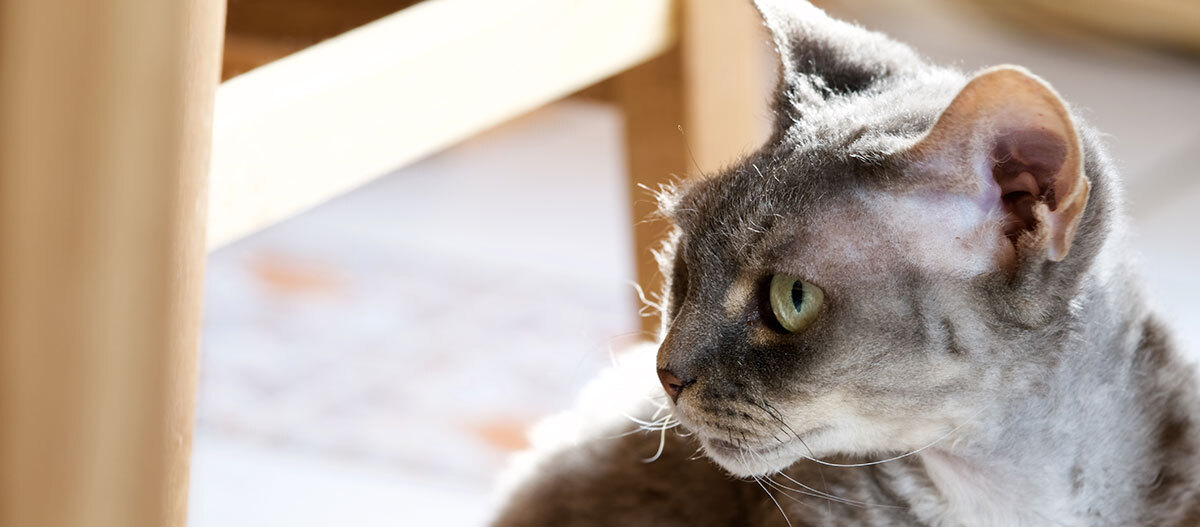Devon Rex – Friendly and People-Oriented with Good Intuition
01.01.2024 - Reading time: 4 minutes

If you are looking for a playful and affectionate cat with a cheeky look, the Devon Rex could be just the right breed for you. But contrary to popular belief, it is by no means a cat for allergy sufferers: while the structure of its coat means it sheds less hair, it is not allergen-free. With its large ears and curly fur, the Devon Rex resembles a bat. In fact, this special purebred cat owes its existence to an incidental coat mutation and the commitment of an ambitious cat lover.
NewsletterDevon Rex
Breed | Devon Rex |
Origin | England |
Size | medium-sized, about 50 cm head-torso length |
Weight | Female cat 2.5 to 3 kg, male 4.5 kg |
Physique | muscular, somewhat bow-legged, long, tapering tail, dainty paws |
head shape | wedge-shaped head |
Eyes | almond-shaped eyes, widely spaced, any colour |
Coat and colour | curly coat without top coat, any colour permitted |
Coat care | brush on a weekly basis with a very soft brush |
Special features | whiskers and eyebrows curled, bat ears, prone to gingivitis |
Nature | friendly, funny, people-orientated, sensitive, playful, intelligent, self-willed |
Devon Rex: Nature
With its friendly and people-oriented nature, the Devon Rex is perfect for anyone who wants a sociable pet. These affectionate cats will follow their owners wherever they go. As the Devon Rex is very intelligent, it constantly needs new challenges so that it does not get bored. It loves to play and is also extremely docile. The clever animals usually learn small tricks quickly.
Devon Rex: Keeping and Care
Devon Rex cats are ideal for keeping indoors, especially as their unusual fur will not protect them very well from the cold, wet and sunburn. They are very playful and active cats. They therefore need space to romp around. Devon Rex cats love people and cannot stand being alone for long periods. They get along very well with other cats, so you should give your Devon Rex a playmate. They will soon take command of the household with their headstrong charm and win the heart of every cat lover in no time.
The Devon Rex’s short fur needs regular care. It is best to use only very soft brushes so as not to comb out the fine hairs unnecessarily. The large ears require special attention, which you should carefully clean with cotton wool on a regular basis. The energy requirements of a Devon Rex are slightly higher than those of other cats. This is because their fur is not as warm. The Devon Rex therefore requires a special diet. Nevertheless, you should make sure that the cat does not become too chubby. Also check your house cat’s teeth regularly: Devon Rex cats are prone to gingivitis.
Devon Rex colours
The curly fur of the Devon Rex cat is short and dense with a sparse top coat. The breed standard recognises any colour and pointing of the coat, as well as all eye colours. Hairless parts of the body, however, are not desirable.

The history of the Devon Rex
So how did the “goblin cat” come about? In 1960, Miss Beryl Cox of Devonshire, England, was fortunate enough to receive a litter of kittens whose father had curly fur. Among the kittens was a curly-haired male named Kirlee. Miss Cox had previously observed cats with curly fur and concluded that the unusual coat structure was hereditary and could be achieved through breeding. This was the beginning of targeted mating, which produced an oriental-looking, slightly bow-legged cat of medium stature. This breed was officially recognised as early as 1967. Since then, the goblin-like kitten with large ears has repeatedly shone as a star at shows. Breeding began in Germany in 1970.
It is also interesting to note that the breed name “Rex” can be traced back to a rabbit. In 1870, the Belgian King Leopold II tried to enter a curly animal in a show. As the monarch could not be refused, the exhibitors improvised and elevated the animal to the breed status “Rex rabbit”, which in turn inspired cat lovers.
Special features of the Devon Rex
The Devon Rex is considered to be particularly stress-resistant. Its strong nerves are proven at shows. It is also said to have a good intuition which enables it to confront strangers and unfamiliar situations.
Finally it should be noted: this breed is discussed as a torture breed, because curled touch hairs (crippled organ) can occur in them.
Important note on the cultivated breed
Frizzy haired cats do not have functional vibrissae on the head or body (they are usually also frizzy). As tactile hairs are an essential sensory organ for the cat, their absence or their transformation leading to non-functionality is to be considered a trait of torment.
The tactile hairs are particularly important for orientation in the dark, but also for catching and scanning prey, examining objects and establishing social contacts. For cats without or with curled hairs, the BMELV report recommends a breeding ban.





